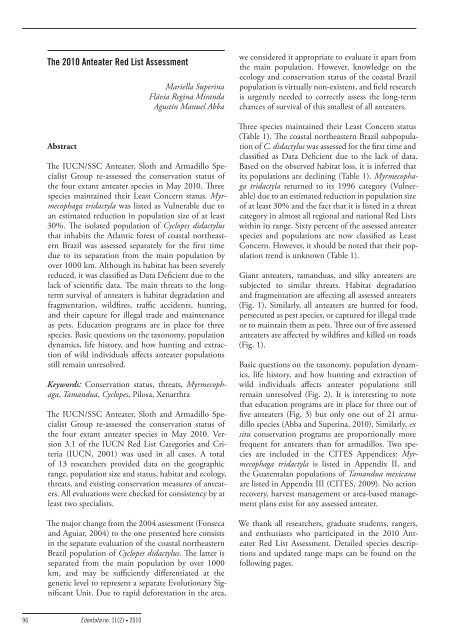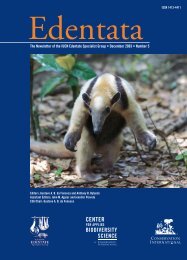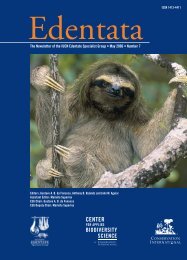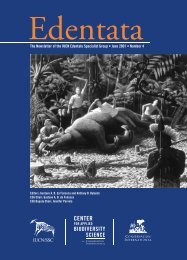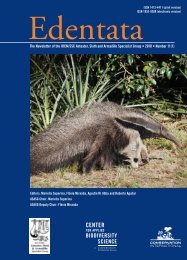Edentata 11(2), 2010 - Anteater, Sloth & Armadillo Specialist Group
Edentata 11(2), 2010 - Anteater, Sloth & Armadillo Specialist Group
Edentata 11(2), 2010 - Anteater, Sloth & Armadillo Specialist Group
- No tags were found...
You also want an ePaper? Increase the reach of your titles
YUMPU automatically turns print PDFs into web optimized ePapers that Google loves.
The <strong>2010</strong> <strong>Anteater</strong> Red List AssessmentAbstractMariella SuperinaFlávia Regina MirandaAgustín Manuel AbbaThe IUCN/SSC <strong>Anteater</strong>, <strong>Sloth</strong> and <strong>Armadillo</strong> <strong>Specialist</strong><strong>Group</strong> re-assessed the conservation status ofthe four extant anteater species in May <strong>2010</strong>. Threespecies maintained their Least Concern status. Myrmecophagatridactyla was listed as Vulnerable due toan estimated reduction in population size of at least30%. The isolated population of Cyclopes didactylusthat inhabits the Atlantic forest of coastal northeasternBrazil was assessed separately for the first timedue to its separation from the main population byover 1000 km. Although its habitat has been severelyreduced, it was classified as Data Deficient due to thelack of scientific data. The main threats to the longtermsurvival of anteaters is habitat degradation andfragmentation, wildfires, traffic accidents, hunting,and their capture for illegal trade and maintenanceas pets. Education programs are in place for threespecies. Basic questions on the taxonomy, populationdynamics, life history, and how hunting and extractionof wild individuals affects anteater populationsstill remain unresolved.Keywords: Conservation status, threats, Myrmecophaga,Tamandua, Cyclopes, Pilosa, XenarthraThe IUCN/SSC <strong>Anteater</strong>, <strong>Sloth</strong> and <strong>Armadillo</strong> <strong>Specialist</strong><strong>Group</strong> re-assessed the conservation status ofthe four extant anteater species in May <strong>2010</strong>. Version3.1 of the IUCN Red List Categories and Criteria(IUCN, 2001) was used in all cases. A totalof 13 researchers provided data on the geographicrange, population size and status, habitat and ecology,threats, and existing conservation measures of anteaters.All evaluations were checked for consistency by atleast two specialists.The major change from the 2004 assessment (Fonsecaand Aguiar, 2004) to the one presented here consistsin the separate evaluation of the coastal northeasternBrazil population of Cyclopes didactylus. The latter isseparated from the main population by over 1000km, and may be sufficiently differentiated at thegenetic level to represent a separate Evolutionary SignificantUnit. Due to rapid deforestation in the area,we considered it appropriate to evaluate it apart fromthe main population. However, knowledge on theecology and conservation status of the coastal Brazilpopulation is virtually non-existent, and field researchis urgently needed to correctly assess the long-termchances of survival of this smallest of all anteaters.Three species maintained their Least Concern status(Table 1). The coastal northeastern Brazil subpopulationof C. didactylus was assessed for the first time andclassified as Data Deficient due to the lack of data.Based on the observed habitat loss, it is inferred thatits populations are declining (Table 1). Myrmecophagatridactyla returned to its 1996 category (Vulnerable)due to an estimated reduction in population sizeof at least 30% and the fact that it is listed in a threatcategory in almost all regional and national Red Listswithin its range. Sixty percent of the assessed anteaterspecies and populations are now classified as LeastConcern. However, it should be noted that their populationtrend is unknown (Table 1).Giant anteaters, tamanduas, and silky anteaters aresubjected to similar threats. Habitat degradationand fragmentation are affecting all assessed anteaters(Fig. 1). Similarly, all anteaters are hunted for food,persecuted as pest species, or captured for illegal tradeor to maintain them as pets. Three out of five assessedanteaters are affected by wildfires and killed on roads(Fig. 1).Basic questions on the taxonomy, population dynamics,life history, and how hunting and extraction ofwild individuals affects anteater populations stillremain unresolved (Fig. 2). It is interesting to notethat education programs are in place for three out offive anteaters (Fig. 3) but only one out of 21 armadillospecies (Abba and Superina, <strong>2010</strong>). Similarly, exsitu conservation programs are proportionally morefrequent for anteaters than for armadillos. Two speciesare included in the CITES Appendices: Myrmecophagatridactyla is listed in Appendix II, andthe Guatemalan populations of Tamandua mexicanaare listed in Appendix III (CITES, 2009). No actionrecovery, harvest management or area-based managementplans exist for any assessed anteater.We thank all researchers, graduate students, rangers,and enthusiasts who participated in the <strong>2010</strong> <strong>Anteater</strong>Red List Assessment. Detailed species descriptionsand updated range maps can be found on thefollowing pages.96<strong>Edentata</strong> no. <strong>11</strong>(2) • <strong>2010</strong>


